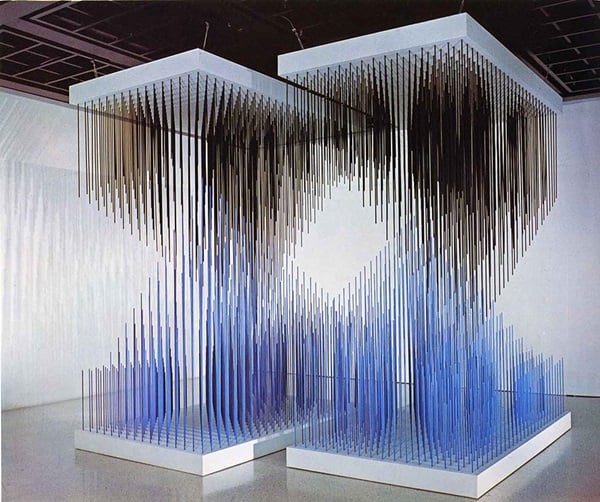
Jesús Rafael Soto Pénétrable BBL bleu (1999) – Edition Avila
© Jesús Rafael Soto / Artists Rights Society (ARS), New
York/ADAGP, Paris, 2015
Courtesy Galerie Perrotin
By all accounts, Jesús Rafael Soto—frequently called art history’s leading kinetic artist—had an illustrious career even during his lifetime. International recognition and demand from collectors, particularly in Europe and Latin America, made for a thriving market for the artist, who was born in Venezuela in 1923 and eventually relocated to Paris where he died in 2005. Now, thanks to a recent spate of high-profile solo and group shows at museums, attention to the artist and his groundbreaking work is growing even more intense.
Today (January 15), Perrotin Gallery, which now represents the Soto estate, is opening concurrent solo shows at its New York and Paris branches (see 15 Things We’re Excited For in 2015). Titled “Chronochrome,” they were curated by Matthieu Poirier, who also curated the lauded kinetic survey “Dynamo” at Galeries Nationales du Grand Palais in 2013. Soto was also the focus of a major retrospective at the Musée National d’Art Moderne and the Centre Pompidou (2013) and he was featured prominently in the Guggenheim’s recent show, “ZERO: Countdown to Tomorrow 1950s-60s” (which closed January 7). The artist had already gone pretty far by the mid-1970s; the Guggenheim gave him a major solo retrospective 40 years ago.
This past summer, the Museum of Fine Arts Houston showcased Soto’s final work, Houston Penetrable (1996), which it called his most ambitious work; it is the only one he designed as permanent or semi-permanent and one of only a handful created as an indoor piece. Penetrable filled the Museum’s 2,600-square-foot Cullinan Hall with 24,000 hand-painted PVC tubes that hang two stories high.
“There is a clear resurgence of interest in his works lately,” said Perrotin Gallery director Peggy Leboeuf, a sentiment that was echoed by the numerous experts artnet News spoke with.
For more than half a century, Leboeuf said, Soto has been considered “one of the artists responsible for a major shift in the history of art, i.e. bringing perception, immateriality, vibration in the spectrum of abstraction, and developing the ideas of the monochrome and the sensorial environment.”
With the help of data from artnet Analytics, we looked at the steady rise in Soto’s market over the past decade. The data show that in 2004, 44 works by Soto were offered at auction. Of these, 33 found buyers and the total of all sales combined was $893,483. By comparison, in 2014, 152 lots, or more than triple, were offered, of which 127 sold, for a total of $6.5 million, indicating far more offerings and a strong sell-through rate.
“In the old days we would include one or two pieces by the artist in a sale,” Axel Stein, Sotheby’s director of Latin American art told artnet News. “Today, we are not afraid to see six pieces in our sales. The success rate is very high.”
Indeed most of Soto’s works turn up at major biannual Latin American art sales at Sotheby’s, Christie’s, and Phillips.
“In Latin America, the collectors are looking for early, historically significant works from the 1960s and 1970s,” said Virgilio Garza, head of Latin American paintings at Christie’s. “Soto also finds a great response from private institutions such as at the Blanton Museum of Art: The University of Texas at Austin which showcases large-scale works by the artist. ”
The current auction record for a work by Soto is $1,082,500 (estimate: $700,000–900,000) for The Hacksaw (1960), a work made of paint, plaster, and metal on hardboard, which sold at a Latin American art sale at Sotheby’s New York in November 2012.
“The record for a Soto work in 2000 was $93,000,” notes Stein. “The record for Soto in 2005 was $419,000, the record was $758,000 by 2010 and by 2014, there are two prices over $1 million,” he said. In addition to the interest from institutions, Stein further credits “renewed interest after many traveling exhibitions of important collections such as Patricia Phelps de Cisneros and Ella Cisneros in the U.S. and Europe” with Soto’s rising market.
Still, it is perhaps somewhat surprising for an artist of Soto’s stature that, to date, only two works at auction have broken the $1 million barrier at a time when auction prices for other top-selling Latin American contemporaries (think Wifredo Lam and Fernando Botero) regularly go well into the millions. The second-highest auction price was for Untitled (Vibration Yellow and White) (1960), that sold for $1,022,500 (estimate: $400,000–600,000) at Sotheby’s New York in May 2012.
“The demand for Soto’s work has increased over the past decade, in part due to the growing appreciation and market interest in Latin American avant-garde movements, like those of geometric abstraction and kinetic art,” Laura González, the director of the Latin American sale at Phillips, told artnet News. “These movements resonate with contemporary aesthetics today, and they strongly appeal to collectors across categories.”
Garza said the renewed interest in Soto, “specifically from the significant time period of the 1960s and 1970s, is consistent with the recent appeal of artists from mid-century art and design. What is evident is that the public is taking a look back at who and what made those landmark, pivotal contributions, who, in the past, may have been overlooked.”
“With a permanent serious gallery representing the artist in the United States,” Stein predicts, “we believe that the exposure will grow and the presence of the artist in the primary market will be more visible than in the past.”
Gonzales also expects the collector base to broaden. “Soto’s market was always international—his long-time gallery, Denise René, is based in Paris. Although still fueled mainly by Latin American and European collectors, the buyer pool for Soto works has become increasingly diverse, with collecting interest growing in Asia and North America. He has also attracted a great deal of institutional attention worldwide, which has helped expose his oeuvre to new audiences outside of his milieu.”